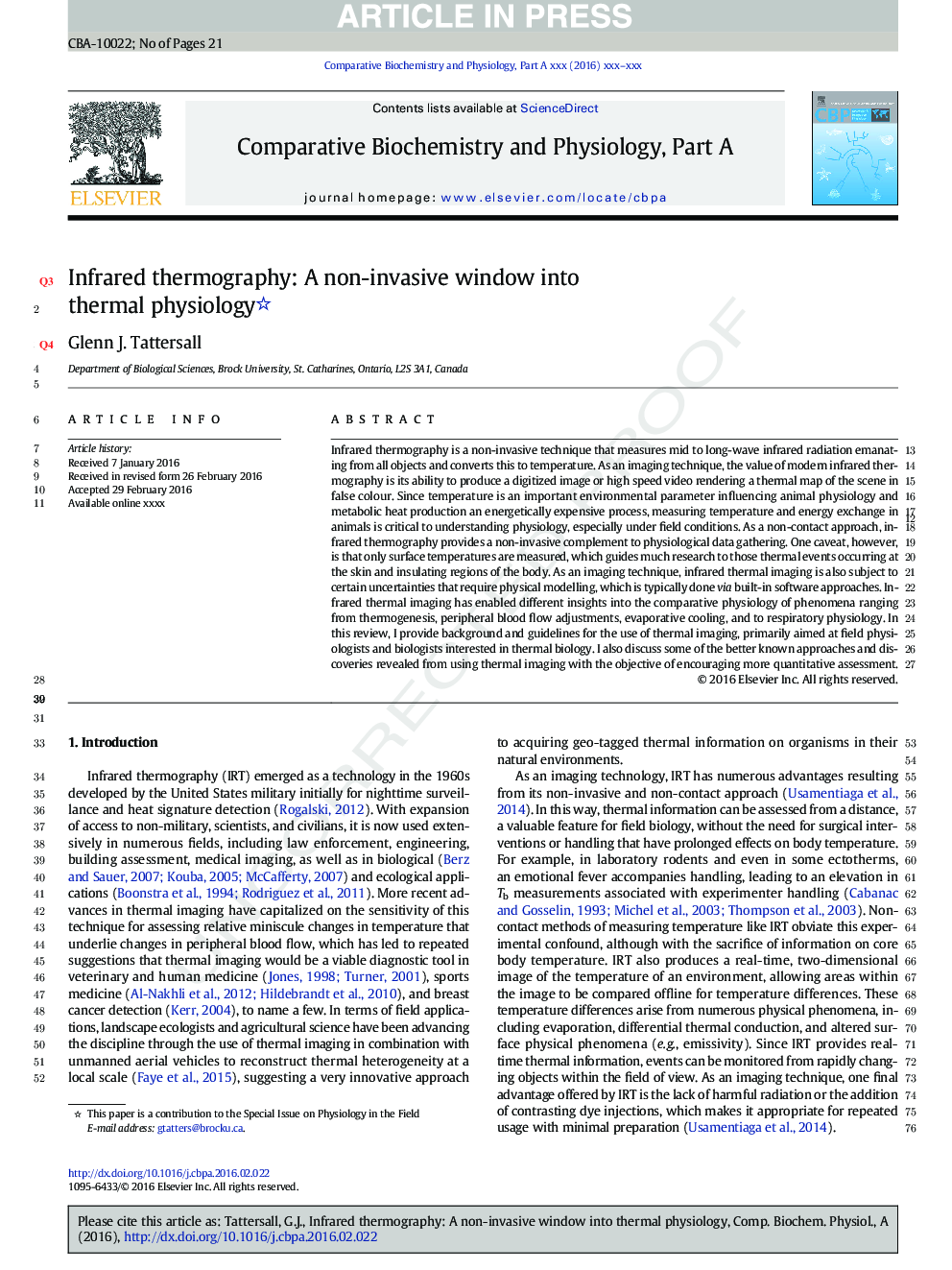| کد مقاله | کد نشریه | سال انتشار | مقاله انگلیسی | نسخه تمام متن |
|---|---|---|---|---|
| 5510353 | 1538985 | 2016 | 21 صفحه PDF | دانلود رایگان |
عنوان انگلیسی مقاله ISI
Infrared thermography: A non-invasive window into thermal physiology
ترجمه فارسی عنوان
ترموگرافی مادون قرمز: یک پنجره غیر تهاجمی به فیزیولوژی حرارتی
دانلود مقاله + سفارش ترجمه
دانلود مقاله ISI انگلیسی
رایگان برای ایرانیان
ترجمه چکیده
ترموگرافی مادون قرمز یک تکنیک غیر تهاجمی است که اندازه گیری اشعه مادون قرمز موج میانه ای را که از همه اشیاء به وجود می آید اندازه گیری می کند و این را به دمای تبدیل می کند. به عنوان یک تکنیک تصویربرداری، ارزش ترموگرافی مادون قرمز مدرن، توانایی آن در تولید یک تصویر دیجیتالی یا تصویر با سرعت بالا است که یک نقشه حرارتی از صحنه را با رنگ نادرست ارائه می دهد. از آنجا که دما یک پارامتر محیط زیستی مهم و تأثیرگذار بر فیزیولوژی حیوانات و تولید حرارت متابولیک است، یک فرآیند انرژی گرانقیمت، اندازه گیری دما و تبادل انرژی در حیوانات برای فیزیولوژی، به ویژه در شرایط مزرعه بسیار مهم است. به عنوان یک روش غیر تماس، ترموگرافی مادون قرمز یک مکمل غیر تهاجمی برای جمع آوری داده های فیزیولوژیکی است. با این حال، یکی از احتمالات این است که تنها دمای سطح اندازه گیری می شود، که تحقیقات زیادی را به حوادث حرارتی ناشی از پوست و مناطق عایق بندی بدن هدایت می کند. به عنوان یک تکنیک تصویربرداری، تصویربرداری حرارتی مادون قرمز نیز به عدم اطمینان خاصی نیاز دارد که نیاز به مدلسازی فیزیکی دارد، که معمولا از طریق روشهای ساخته شده در نرم افزار انجام می شود. تصویربرداری حرارتی مادون قرمز بینش های مختلفی را نسبت به فیزیولوژی مقایسه ای از پدیده های ترموژنز، تنظیمات جریان خون محیطی، خنک کننده تبخیری و فیزیولوژی تنفسی داشته است. در این بررسی، من زمینه و دستورالعمل های استفاده از تصویربرداری حرارتی را ارائه می دهم، که عمدتا در زمینه های فیزیولوژیست ها و زیست شناسان علاقه مند به زیست شناسی حرارتی است. همچنین در مورد برخی از رویکردهای شناخته شده و اکتشافی که از استفاده از تصویربرداری حرارتی با هدف تشویق ارزیابی کمی بیشتر صورت گرفته است، بحث می شود.
موضوعات مرتبط
علوم زیستی و بیوفناوری
بیوشیمی، ژنتیک و زیست شناسی مولکولی
زیست شیمی
چکیده انگلیسی
Infrared thermography is a non-invasive technique that measures mid to long-wave infrared radiation emanating from all objects and converts this to temperature. As an imaging technique, the value of modern infrared thermography is its ability to produce a digitized image or high speed video rendering a thermal map of the scene in false colour. Since temperature is an important environmental parameter influencing animal physiology and metabolic heat production an energetically expensive process, measuring temperature and energy exchange in animals is critical to understanding physiology, especially under field conditions. As a non-contact approach, infrared thermography provides a non-invasive complement to physiological data gathering. One caveat, however, is that only surface temperatures are measured, which guides much research to those thermal events occurring at the skin and insulating regions of the body. As an imaging technique, infrared thermal imaging is also subject to certain uncertainties that require physical modelling, which is typically done via built-in software approaches. Infrared thermal imaging has enabled different insights into the comparative physiology of phenomena ranging from thermogenesis, peripheral blood flow adjustments, evaporative cooling, and to respiratory physiology. In this review, I provide background and guidelines for the use of thermal imaging, primarily aimed at field physiologists and biologists interested in thermal biology. I also discuss some of the better known approaches and discoveries revealed from using thermal imaging with the objective of encouraging more quantitative assessment.
ناشر
Database: Elsevier - ScienceDirect (ساینس دایرکت)
Journal: Comparative Biochemistry and Physiology Part A: Molecular & Integrative Physiology - Volume 202, December 2016, Pages 78-98
Journal: Comparative Biochemistry and Physiology Part A: Molecular & Integrative Physiology - Volume 202, December 2016, Pages 78-98
نویسندگان
Glenn J. Tattersall,
